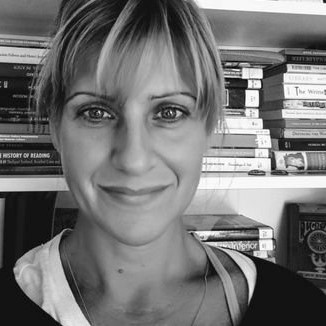
Resources Invitation to contribute
This is an invitation to add resources to the BANG! website:
www.cenl.org/networkgroups/books-and-audiences-network-group
Please tell us about the resources (e.g., publications, websites, images, films, audio) you have found helpful, inspiring, or useful in your work to engage audiences with books and books with audiences.
1. Your name
Susana Sanchez-Gonzalez
2. Your contact details
- Susana.sanchez-gonzalez@manchester.ac.uk
- Connect with me @theTLtweets
3. Would you like to add a photo?

4. What is your job title, the name of the organisation you work for, or to which you are affiliated? What is your role there?
PhD student in Museology at the Institute for Cultural Practices, University of Manchester, UK (part-time)
PhD title: Opening the “numinous” book: Exploring the “reading experience” and “bookish emotions” as curatorial and engagement tools in book exhibitions.
5. What is your interest in the subject of books and audiences?
I am a second year PhD student in Museology at the University of Manchester’s Institute for Cultural Practices in the UK. My work focuses on ‘the reading experience’ and the idea of the book as a ‘numinous’ object, that is, as an “emotionally charged” object. I am exploring how curators may employ these concepts to advance the theory and practice of book exhibitions. In contrast to previous research, I want to build a new theoretical framework where we give due attention to the material and affective capabilities of books as exhibition objects as well as to the role of books and reading-related emotions in shaping the visitor’s exhibition experience.
In addition to visitor studies and museum-based research on object interpretation, emotions, and experience, I bring to the discussion some of the concepts and terminology that literature scholars, book artists and cultural sociologist have employed to allude to the range of emotional connections that might be established between people and books through (and beyond) the reading experience. These are concepts like “bookishness”, “book presence” and “book love”. Broadly speaking, these terms seek to capture the significations and valences that the book as an object has acquired against the background of the digital shift. In my research, I question whether these concepts may also be fruitful to investigate what brings people to book exhibitions and what it is they find of value in their visiting experiences. Likewise, I want to explore their potential in evidencing the peculiarities of the book as an exhibition object as well as their role in the way in which we interact with this object as viewers: are “bookish connections” strong enough to create opportunities for emotion and experience in exhibitions? What are the benefits, challenges, and limitations of supporting emotional bonds and reading experiences through exhibition design and interpretation? These are all key areas of interest in my research.
This thesis builds on my MA in Art Gallery and Museum studies, my training as Rare Book Librarian, and my extensive experience working as reader and public engagement specialist in public, school, and historic libraries in the UK. You can read a more detailed description of my research here:
6. Recommended resources
Collection Trust. (n.d.). https://collectionstrust.org.uk/resource/guidance-for-exhibiting-archive-and-library-materials/
Cullingford, A. (2016). The special collections handbook. Facet Publishing.
Dutka, A., Hayes, S., & Parnell, J. (2019). The surprise part of a librarian’s life: Exhibition design and preparation course. College & Research Libraries News, 63(1), 19–23
Fouracre, D. (2015). Making an exhibition of ourselves? Academic libraries and exhibitions today. The Journal of Academic Librarianship, 41(4), 377–385.
Harris, V. A., & Weller, A. C. (2012). Use of special collections as an opportunity for outreach in the academic library. Journal of Library Administration, 52(3–4), 294–303
Keith, B. W., Taylor, L. N., & Santamaría-Wheeler, L. (2017). Broadening impact for library exhibitions and speakers. Journal of Library Administration, 57(4), 389–405
Marini, F. (2019). Exhibitions in special collections, rare book libraries and archives: Questions to ask ourselves. Alexandria, 29(1-2), 8-29
Matassa, F., 2014. Organizing Exhibitions: a handbook for museums, libraries and archives. Facet Publishing.
National Library of Scotland, University of Edinburgh, Vincent, H. (2011). Exhibiting the Written Word Report. https://www.nls.uk/about-us/working-with-others/rare-books-in-scotland/documents/exhibiting-the-written-word
Priddle, C. (2015). “Bridging the Internal Gap: Special Collections and ‘In-Reach.’” RBM : A Journal of Rare Books, Manuscripts, and Cultural Heritage, 16(1).
Reed, M. (2007). Blurring the boundaries: collaborative library and museum exhibitions in Los Angeles. RBM: A Journal of Rare Books, Manuscripts, and Cultural Heritage, 8(1), 45–50.
Robinson, H. (2018). Curating convergence: interpreting museum objects in integrated collecting institutions. International Journal of Cultural Policy, 24(4), 520–538.
Swanick, S., Rankin, S., & Reinhart, M. (2015). Curating exhibitions in academic libraries: Practical steps. Practical Academic Librarianship: The International Journal of the SLA Academic Division, 5(2), 1–22.
Taylor, M. L. (2018). Special Collections Exhibitions: How They Pay Dividends for Your Library. RBM: A Journal of Rare Books, Manuscripts, and Cultural Heritage, 19(2), 121.
Traue, J. E. (1991). Committed to Print: Selected Essays in Praise of the Common Culture of the Book. Victoria University Press. ***Early attempt at looking at exhibitions from a DESING point of view***
Vincent, H. (2012). The Library and the Display of Text. https://www.ifla.org/past-wlic/2012/87-vincent-en.pdf
Visser, M. (2004). Considerations in the preparation of library exhibits featuring rare books and manuscripts. College & Undergraduate Libraries, 11(2), 51–62
7. How have these resources been used?
These are some of the titles that I have discussed in the literature review chapter of my PhD. It gives an overview of the main issues covered by academic studies on book exhibitions to date. The bulk of this literature pertains to exhibitions taking place in library settings (particularly, in academic libraries) and has been carried out by Library and Information Science scholars. As such, it provides possible solutions to the managerial challenges of exhibiting RBSC material together with clear guidelines for the preservation and conservation of these items whilst on display. In addition, the literature offers an insight into the different ways in which the exhibition exercise may be utilised by library-curators to build on their expertise as “professionals of the book”, to advance in their careers and to develop positive and meaningful relationships with other communities and stakeholders. Anyone looking for a place to start learning about book exhibitions will find these studies engaging and of great practical value. As I said above, I hope my research will soon contribute to these studies with new perspectives on the visitor experience and the book as exhibition object.


Leave a Reply